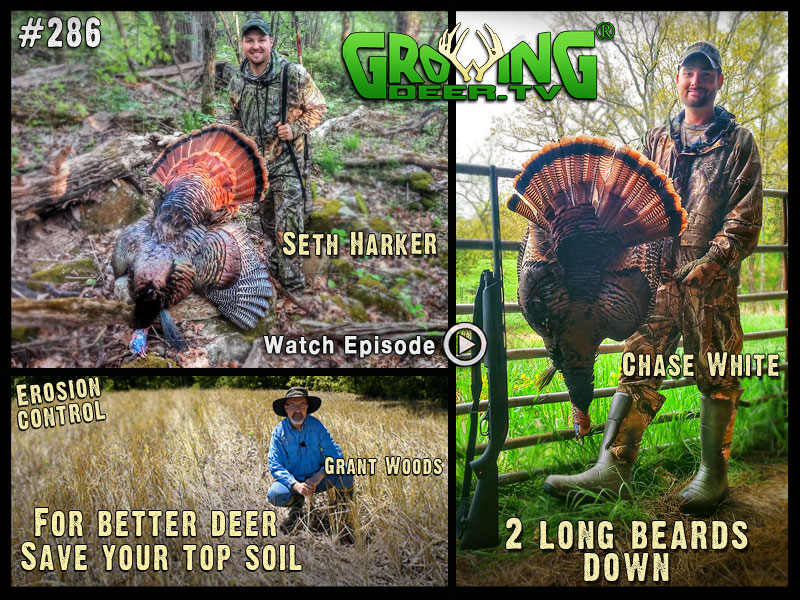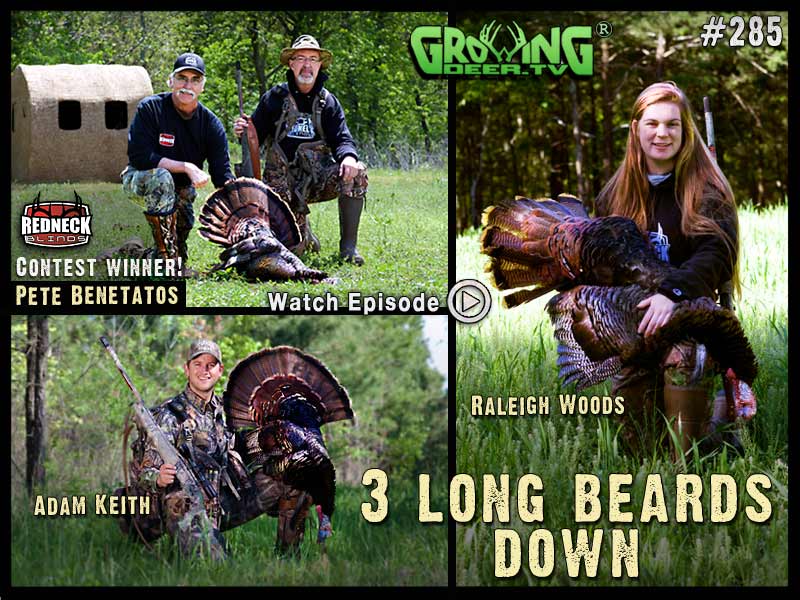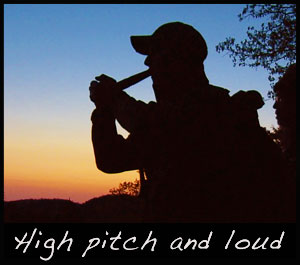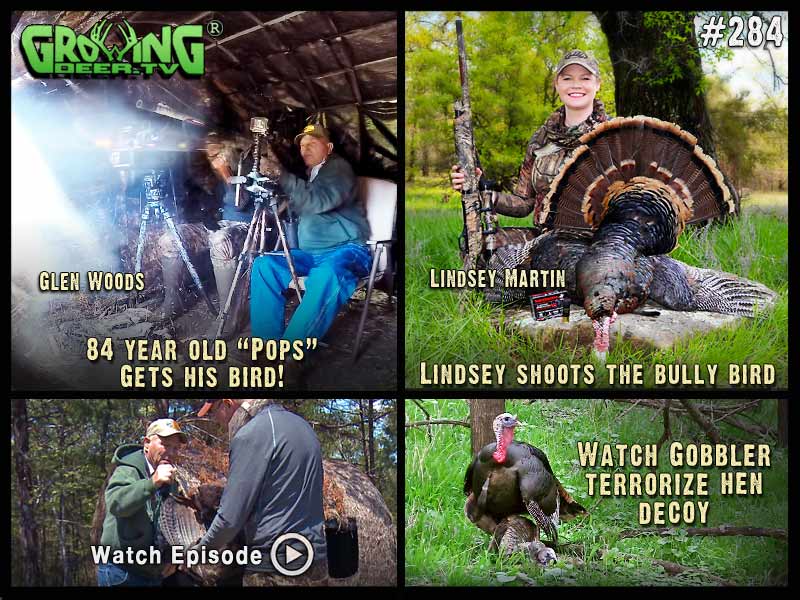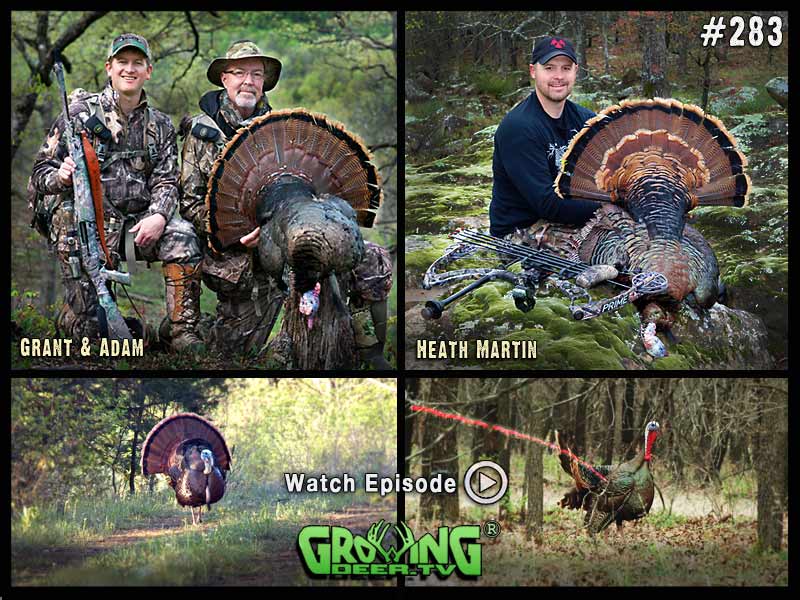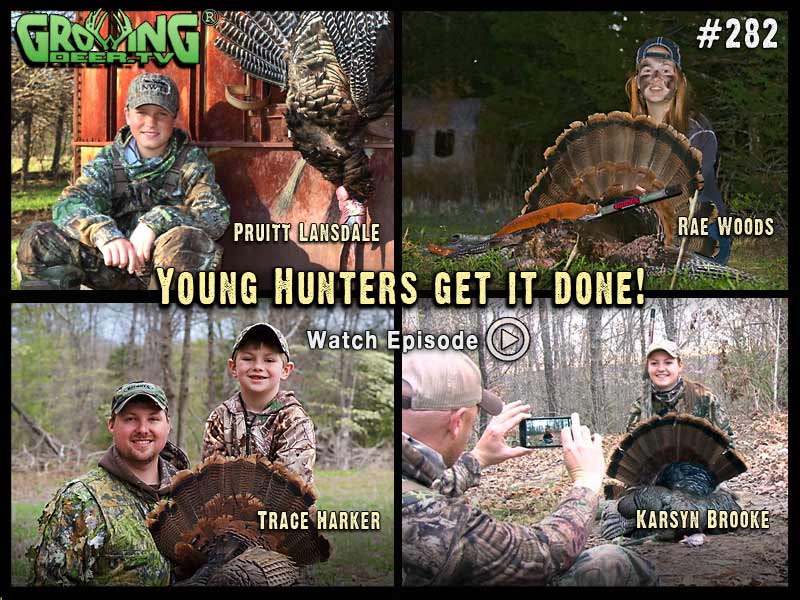Category: Turkey Hunting
Better Food Plots – Episode #286
Erosion control means better soil. Better soil means larger deer. Grant’s got easy tips for saving and building valuable top soil!
Here we go! Chase and Seth are running and gunning. With heavy rains about to hit, they’re set up on a hot gobbler, but this bird better hurry or our boys will be wet and out of luck! Then Seth goes solo hunting, where he sets up decoys in the perfect spot. Wow! It’s a full strut hammering.
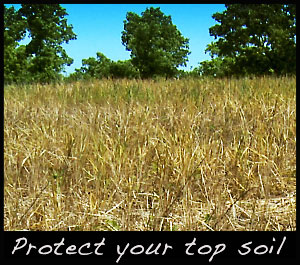 Tip of the Week:
Tip of the Week:
Want better deer?
Keep your valuable top soil.
Avoid erosion by always having
a crop in the field and not disturbing the soil!
Three Long Beards Down! – Episode #285
This week Grant and Adam take the Redneck Blind sweepstakes winner turkey hunting. They get in a pile of turkeys! Then Adam and Seth team up and call in a big ‘ol gobbler. Not to be outdone, it’s Raleigh Woods turn behind the Winchester. It’s a father daughter turkey hunt. Watch Grant and Raleigh scramble to kill a big tom. It’s fast action as Raleigh locks on and pulls that trigger!
Need to locate ’em?
Try high pitched and loud.
Owl hoots & coyote calls work great.
Spring Turkey Hunting: A Recipe To Treat Your Mother
If you’ve been blessed with a successful turkey hunt and have a recently harvested turkey in your freezer, you now have a great meal for your mother this Sunday! Treat her to a home cooked meal of the best kind – natural, free-range wild turkey nuggets!
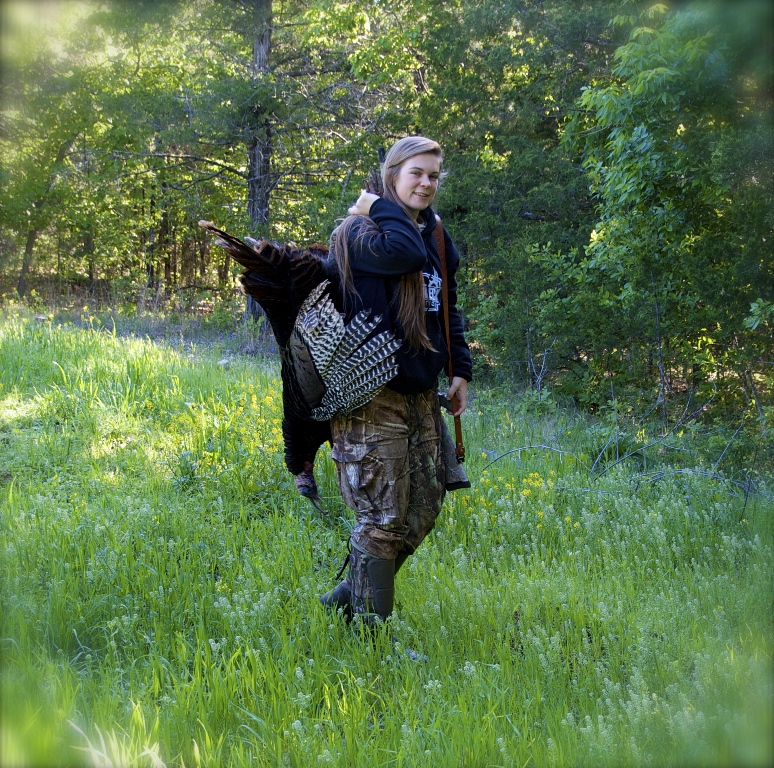
Raleigh provided a wild turkey for the freezer!
Salt
Pepper
Powdered garlic
Basil
Dash of paprika
Dash of cayenne pepper
4 cups all-purpose flour
1 cup cornmeal
Oil, for frying
Directions:
Fill a fryer or deep pot halfway with oil. Heat to 350 degrees F. Sprinkle the turkey nuggets liberally with salt, pepper, powdered garlic, and basil. Sprinkle the turkey nuggets with a dash of paprika and cayenne pepper. In a gallon size Ziploc© bag combine the flour and the cornmeal. Add the nuggets to the Ziploc© bag, close, then shake to cover the nuggets with the flour mixture. Remove the nuggets from the bag. Using a slotted spoon place the nuggets in the fryer. Deep fry for approximately 8 to 10 minutes until done. Drain on paper towels. Serve with baked potato or corn on the cob and a fresh green salad!
Variations:
- Marinate the turkey nuggets in your favorite BBQ sauce for a minimum of 30 minutes before breading (Grant likes a mustard base!).
- If you like a heavier breading, add 1 egg and ½ cup milk to the flour mixture (it should be roughly the consistency of pancake batter).
- Use this same batter recipe to cook fish, onion rings, mushrooms, etc. (And since you’ve tagged your turkey, what better reason to enjoy this beautiful spring weather than adding some fish to the menu!)
- If using it for cooking fish I recommend Old Bay or a cajun seasoning to replace the garlic and basil.
If you haven’t filled your tag yet (and the season is still open in your state) this recipe will give you a good reason (or excuse) to get out in the woods on Saturday. After all – it’s all for you, Mom!
Looking forward to my Mother’s Day meal,
Tracy
Turkey Season 2015 – Episode #284
More birds down! What a great tradition, watch 84 year old “Pops” put the hammer down on dinner! Then Lindsey Martin takes out a Kansas bully bird! Plus, wow! Watch a gobbler terrorize a Montana hen decoy…then pay the price.
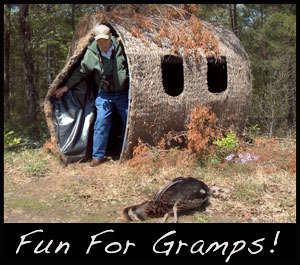 Tip of the Week:
Tip of the Week:
Taking Grandpa hunting?
A large blind makes the hunt more enjoyable for him!
Turkey Nests And Predator Control
Turkey hunters, mushroom hunters, and other outdoor enthusiasts have been spending time in the outdoors during this time of year. There are so many beautiful pieces of God’s creation showing their full color right now, and no one should be missing it! One of my favorite things to see in the spring is turkeys, and even better, turkey nests! Finding one of these can be a real treat, and for those who pride themselves as “wildlife managers” we wonder, “How can we help these eggs?”
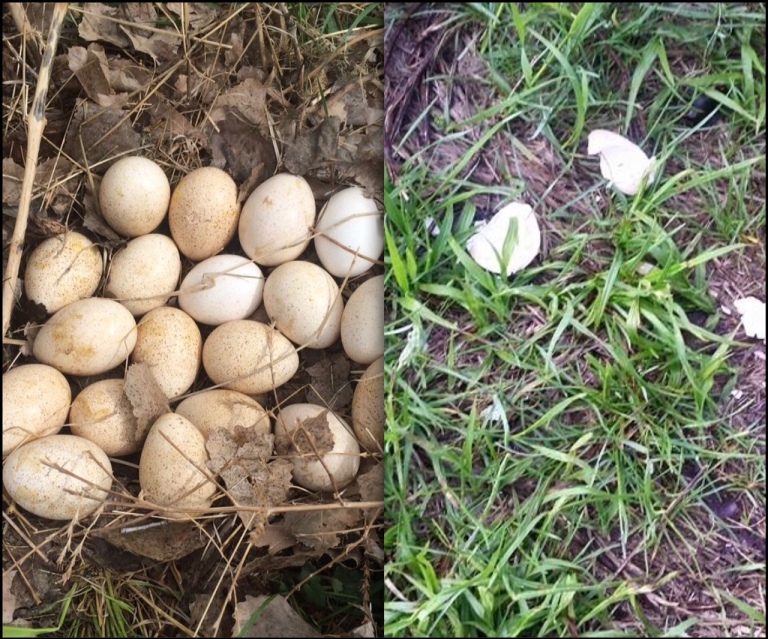
(Left) A healthy turkey nest with several eggs and no sign of predators. (Right) What happens when a nest predator finds the eggs.
As wildlife managers, it’s in our blood to try and improve the overall habitat quality and wildlife population. If you’re like me when you find something as frail as a turkey nest you want to step up your game to ensure these eggs will hatch and reach maturity. Obviously you can’t save all the turkey nests, but you can ensure that some of them will make it past birth.
First we need to understand that predators will harm the eggs, mother hen, and the newborn turkeys. Coyotes and bobcats prey on all of these, and definitely get the most attention as turkey predators, but don’t overlook the small predators like raccoons, opossums, and skunks. These small animals can definitely hurt the turkey population if their numbers are plentiful.
Lesson Learned – When trapping season is open in your area, put out your traps! Don’t stick with one set of traps and try to remove coyotes and bobcats either. Pick up some small traps to balance the predator prey relationship in your area! We use Duke Dog Proof or Duke Cage traps because they are simple and easy to use. Trapping turkey nest predators will save turkey lives, and who doesn’t want to enjoy a spring morning with turkeys gobbling?
Daydreaming of long beards and long spurs,
Adam
Hunting Gobblers – Episode #283
Double trouble! Has this happened to you? You have two gobblers fired up. You can’t see them yet. One bird is out front, the other directly behind and closing fast. Tick-tock, you gotta make a decision! Watch this episode to see how Grant and Adam handle this double trouble situation. Then, we travel to Kansas with Heath and Lindsey Martin as they bow hunt the beautiful Rio-Eastern hybrid. Will Heath arrow a big tom before the storm hits? Watch and see these hunts unfold!
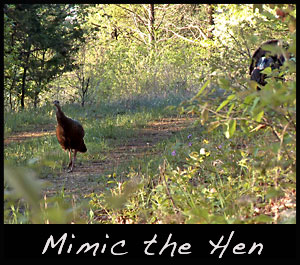 Tip of the Week:
Tip of the Week:
Hear a hen? Try imitating her.
She’ll bring that big tom to you.
Missouri Turkey Season: The Tools Of The Trade
Proclaiming that I love this time of year is a complete understatement. Finding the words to express my happiness with springtime is very difficult. With the temperatures warming and the outdoors coming back to life, things are beautiful here at The Proving Grounds and things got even better this week with the opening of Missouri turkey season! Throughout the spring Grant and I are often asked what calls we use to lure those wary toms into range. Here is a list of exactly what we carry in our vest!
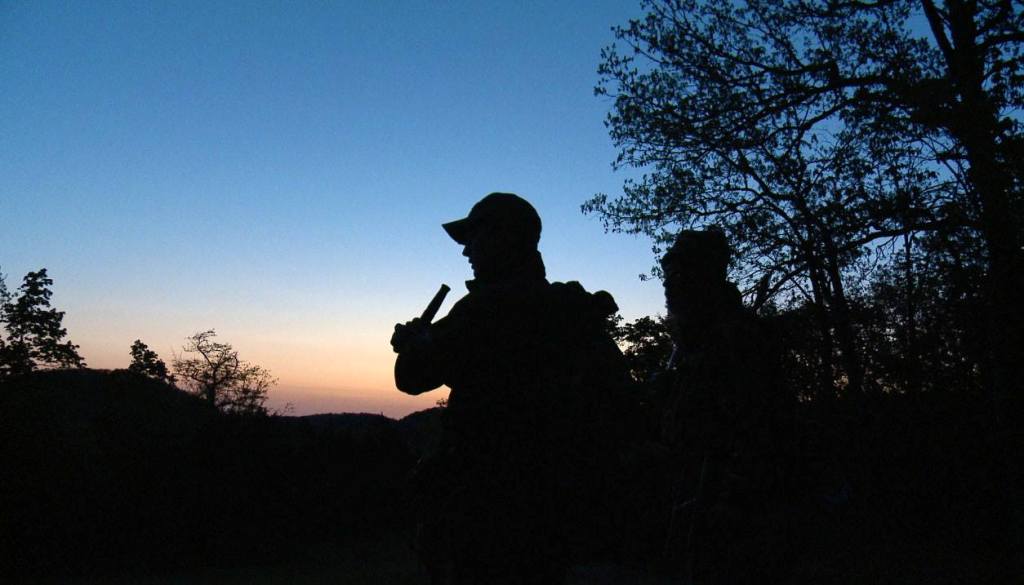
Adam using the Harrison Hoot’n Stick early in the morning trying to locate a gobbler.
Although we use a lot of similar calls there are a few minor differences. You can find all of these calls and more information about them at Hook’s Custom Calls.
Grant’s vest:
- Exterminator (crystal glass) – This is Grant’s go to friction call. Teamed up with the Yellowheart gobbler stick it creates great clear to mid rasp sounds.
- Assassin Slate – This call creates a wide range of tone but its specialty is those soft tree yelps early in the morning.
- Diaphragm Calls – Executioner, Swindler, and the Game Changer 3
My vest:
- Assassin Glass – This is my favorite call to try and tempt that gobbler into range. This glass call can create mid tone raspy yelps to high frequency rasps to locate those toms on the next ridge.
- Assassin Aluminum – Aluminum has been my favorite surface on a friction call for several years. It can hit the high ball rasp that I really love or mid range yelps as the tom approaches our setup.
- Diaphragm Calls – Enforcer, Shockwave, and the Game Changer 3
The locator calls we both use:
- Harrison Hoot’n Stick Walnut – This is almost always the first call we make early in the morning.
- Harrison Crow Call Walnut – As the sun comes up we’ll switch up our locator calls and use a crow call.
- Harrison Howler – Sometimes when birds want to be tight lipped a howl on this call can create a response.
We use these calls daily this time of year and we can’t wait to get back out there again to try our hand one more time!
Daydreaming of long spurs and long beards,
Adam
4 Toms Down! – Episode #282
Watch this special episode! It’s youth turkey season and these kids do not disappoint. We’ve got four birds going down on camera! Plus, four very proud fathers who took their kids hunting. Congratulations to these fathers, sons and daughters.
Tip of the Week: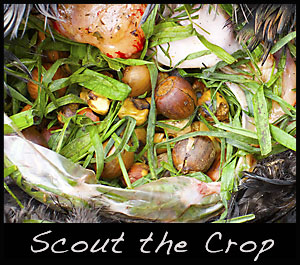
Scout the crop.
Harvest a turkey?
Open up the crop and learn the current favorite foods.
This might be the key that fills your next tag!
Scouting From The Skinning Shed
Several months every year hunters take to the woods to scout for their next hunt. We monitor trail cameras, observe creek crossings, and stare into soybean fields during the late summer for the chance to catch a glimpse of velvet antlers. We do a number of things, but when given the chance to obtain some of the most informative details we often let it slip through our fingers. This important information is something the GrowingDeer.tv Team never passes up and neither should you.
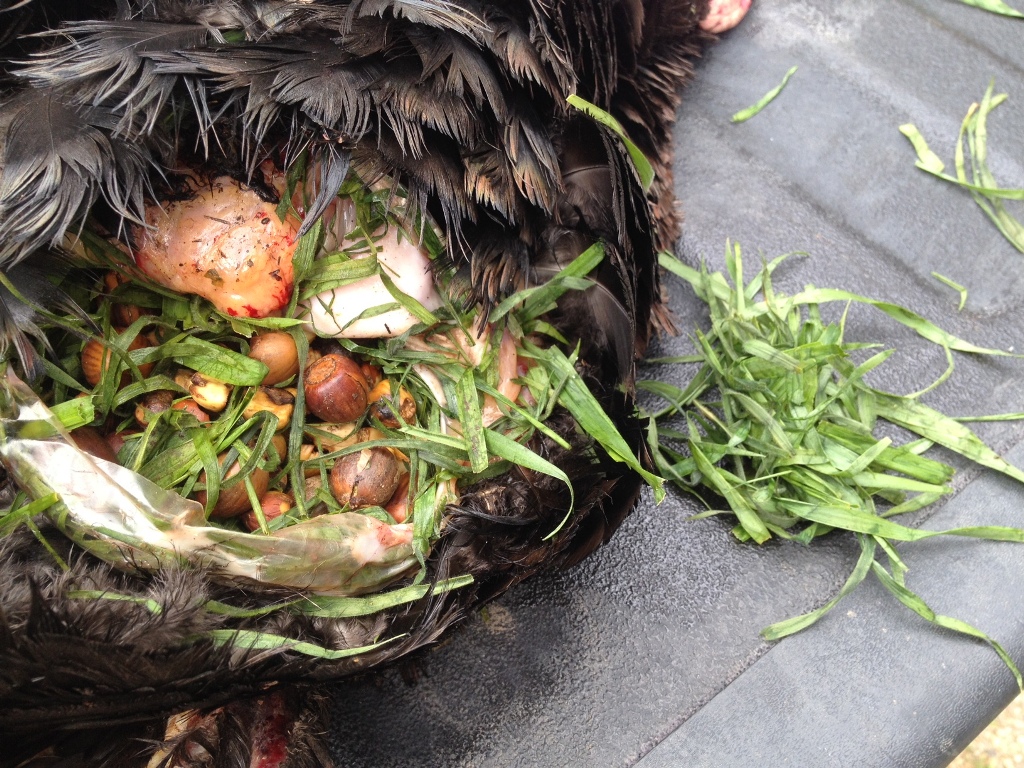
This turkey’s crop was filled with wheat and acorns of every size.
Every successful hunt is a learning experience. On top of all the excitement from the hunt, we can also gain information for our next hunt. Recently, Grant’s youngest daughter, Rae, harvested a nice bird during Missouri’s youth turkey season. The following day I took my Razor Blaze knife and cut into the crop of the turkey. The crop serves as the stomach of the turkey and by inspecting the interior of the crop you can learn where that turkey spent the day feeding. The crop of this specific turkey contained acorns and wheat. No surprise on the wheat, as this turkey was shot in an Eagle Seed Broadside plot which contains several different cool season plants. The acorns told us not to overrule hunting turkeys in the woods.
It’s mid April and a lot of hunters may believe that the acorn consumption is over and that animals will be using other food sources. After looking in the crop of this turkey, we know that’s not true. Season opens up for everyone in Missouri on Monday and you can bet at some point we’ll be chasing turkeys in the timber!
Daydreaming of long beards and long spurs,
Adam
Trail Cameras For Turkey Scouting
March is a great month for turkey hunters. A lot of hunters in the South are already starting their turkey season while Grant and I, who are located in the Midwest, are using this month to scout. March in the Midwest can mean large flocks of turkeys roosted in close proximity to each other. This also means they can be very vocal while on the limb, but finding where they fly down can be difficult sometimes. Using the same trail camera you use for scouting deer, and turning on the time lapse feature can help you find the fly down area and increase your success rate once season opens.
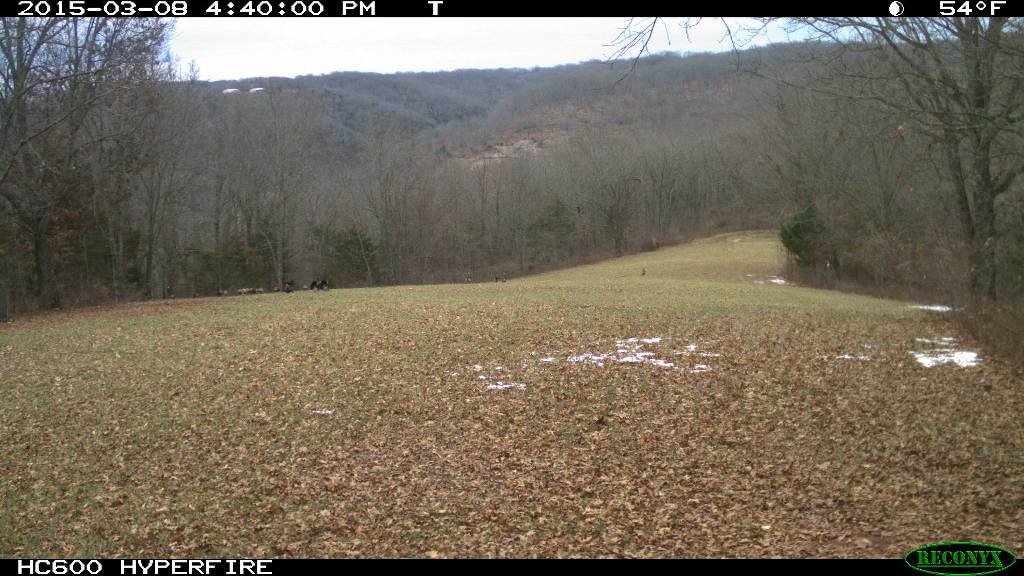
We were able to locate this large flock of turkeys using the time lapse feature on our Reconyx trail camera.
Early in the spring, gobblers are grouped up. During this time they are sorting out dominance so don’t expect them all to be roosted in the same spot a month from now, but they will most likely be close. Once you find their roost location, it’s important to try and find where they fly down and spend the early part of the morning. Although their roost site may change, the areas where they strut and feed will likely be visited throughout the spring. This could be a large field, a small opening in the woods, or a hardwood ridge. Finding this location can be pivotal to your success.
We use our Reconyx cameras and the time lapse feature to find the areas the turkeys are most active in. The time lapse feature allows us to monitor entire fields and hone in on their fly down locations. We set our cameras to take a picture every five minutes from sunrise to two or three hours after sunrise. The cameras will also take motion activated pictures or video if the turkeys are close enough to set off the motion sensor. Using trail cameras is a great way to start your spring so you can be more prepared when turkey season gets here!
Daydreaming of long spurs and long beards,
Adam



